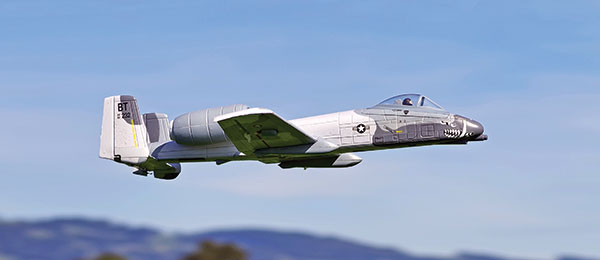
Written by Kyle Jaracz This Aero Commander puts the win in twin! Product review As seen in the Winter 2018 issue of Park Pilot.
Bonus Video
Specifications:
Type: Semiscale BNF Skill level: Intermediate Wingspan: 28.15 inches Length: 20.15 inches Weight: 5.1 to 5.6 ounces Price: $149.99 Info: horizonhobby.comFeatures:
>> Twin brushless motors >> AS3X stabilization technology >> Removable landing gear >> Good flight timesProduct Review
>> Although I’m typically partial to warbirds, I took a chance on the Aero Commander and I’m so pleased that I did. The aircraft comes packaged in a sturdy and protective box. This is no surprise to modelers who have come to expect as much from Horizon Hobby UMX products. This box is slightly larger than many other aircraft in the UMX line. Part of the reasoning I’m sure was to protect the tall, vertical tail in transit. However, rest assured that you can easily get this aircraft to the flying site of your choice. The Commander comes fully assembled, so getting to the fun part of flying is only a battery connection and transmitter binding away. You’ll need to provide your own transmitter and a battery because the BNF (Bind-N-Fly) model doesn’t come with those items.
Transportation and safe storage is one of the perks of purchasing something from the Horizon Hobby UMX series.
After you bind the aircraft to your Spektrum DSM2/DSMX transmitter, pay close attention to the trim and controls. All of the control surfaces on my model responded appropriately with no control rod snags, but care should be taken to ensure that all of the control surfaces are up to snuff. The omission of flaps and retracts allows a simple four-channel transmitter to be used. If you find that you need more than a few clicks of trim on the first flight, you might want to adjust the pushrods by making the U shape narrower or wider to adjust the linkage length. The twin 3,000 Kv motors provide ample power for aerobatic maneuvers. One item of note for those who might not have flown AS3X aircraft, when preparing your model to fly, you must plug in then set the aircraft on its wheels in a level position to set the stability controls. Upon taxiing, you will notice that the steerable nose gear works great on the runway, allowing you to maneuver it on the ground with ease. I took off and landed on a paved runway for each flight, but a hand toss would be easily accomplished with this aircraft. If you prefer to have a more scalelike appearance in the air, the gear is easily removed. Be certain to land in the grass to avoid marring the fuselage. Pay particular attention to the battery placement. I needed to place the battery far back in its tray, placing the center of gravity closer to 20mm back from the wing’s leading edge to achieve a more neutral flight while inverted and powering up. I am using an E-flite 2S 800 mAh LiPo battery. Flight times were easily in the 15-minute range. I could have stayed up longer because I was generally cruising at 1/4 to 1/3 throttle.

The Aero Commander’s battery compartment is surprisingly spacious and can accommodate a range of battery options.
The AS3X kept the aircraft steady in moderate wind. It’s amazing to see such a small airframe flying so marvelously in conditions that I would have never considered flying an aircraft of a similar size in. Although turbulence from trees and buildings still has an effect on the flightpath, the onboard electronics make flying in adverse conditions a breeze—pun intended! If the Aero Commander is able to handle the less-than-ideal conditions like a champ, to truly enjoy the flights to their fullest potential, you’ll have to take it out on a perfect day. The flights are smooth, the power is there when you want it, and the smile on your face will last well past the flight. Performing rolls, loops, and inverted flight are no problem. The color scheme leaves no doubt as to the aircraft’s orientation. This Aero Commander can fly in areas that are smaller than a typical club field. This helps to ensure your local park or small field can be used with ease. I had the opportunity to fly alongside both Matt Ruddick, AMA assistant multirotor editor, and Dillon Carpenter, AMA’s digital media production specialist, as they gathered some chase footage. Take a look online (theparkpilot.org) to see the Aero Commander flying.

It’s not every December day in Indiana that flying without a jacket is possible! Kyle brings the Aero Commander in for a low-and-slow flyby.
I’ll close with a little history lesson. In researching the Aero Commander, I came across the story of Bob Hoover. For those who may not be aware, Bob was a U.S. Air Force fighter pilot, test pilot, and flight instructor who went from hijacking an Fw 190 and escaping a prisoner of war camp in World War II, to stealing the hearts of air show attendees across the nation. One of the aircraft that Bob flew in those air shows was the Aero Commander. That’s just one of the great things about model aeronautics—it serves as an opportunity to learn about those who have “been there and done that.” I have since enjoyed sitting down with my sons and watching footage from the great Bob Hoover and his aerobatic exhibitions. My subsequent flights of the Aero Commander alongside 8-year-old Caleb and 5-year-old Wyatt were filled with shouts of “Eight-point roll!” and “Kill the engines!” Good times at the flying field were had by all. -Kyle Jaracz [email protected]
Article:





